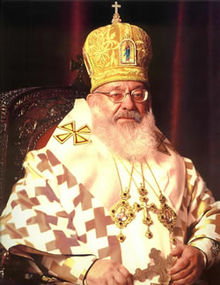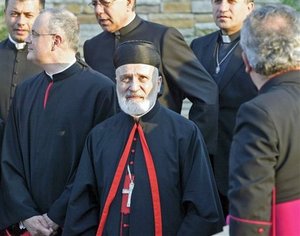 Today, Pope Benedict XVI accepted the petition of His Beatitude, Patriarch Nasrallah Peter Sfeir, cardinal, to retire from his pastoral leadership as the Father of Maronite Church.
Today, Pope Benedict XVI accepted the petition of His Beatitude, Patriarch Nasrallah Peter Sfeir, cardinal, to retire from his pastoral leadership as the Father of Maronite Church.
Tag: Eastern Christianity
Metropolitan Jonah takes time off to re-orient self
 The Orthodox Church in America (OCA), according to reports, has placed Metropolitan Jonah on a leave of absence. The Synod of the OCA acted swiftly to seeming abuse of power. The Metropolitan Jonah, it seems, is facing mounting questions not only over issues of style of management but anger issues.
The Orthodox Church in America (OCA), according to reports, has placed Metropolitan Jonah on a leave of absence. The Synod of the OCA acted swiftly to seeming abuse of power. The Metropolitan Jonah, it seems, is facing mounting questions not only over issues of style of management but anger issues.
Maronites remember founder, Saint Maron
 1600 years is a long time. But the Church never forgets. She especially never forgets a sainted monk who called together others to live the Gospel and to pray. Maronite Church who traces her foundation to a monk is remembering his good work and his death of so long ago. Several celebrations around the US mark the anniversary.
1600 years is a long time. But the Church never forgets. She especially never forgets a sainted monk who called together others to live the Gospel and to pray. Maronite Church who traces her foundation to a monk is remembering his good work and his death of so long ago. Several celebrations around the US mark the anniversary.
Transitioning from Husar to new era in the Ukrainian Church …?
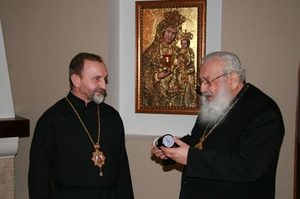 In the past weeks we’ve seen the Pontiff accepting the resignation of His Beatitude Cardinal Lubomyr Husar, 78, as the Major Archbishop of the Ukrainian Catholic Church. Bishop Ihor Voznyak is the temporary administrator of the Church until a new leader is elected.
In the past weeks we’ve seen the Pontiff accepting the resignation of His Beatitude Cardinal Lubomyr Husar, 78, as the Major Archbishop of the Ukrainian Catholic Church. Bishop Ihor Voznyak is the temporary administrator of the Church until a new leader is elected.
Continue reading Transitioning from Husar to new era in the Ukrainian Church …?
Lubomyr Cardinal Husar, MSU, Major Archbishop of the Ukrainian Catholic Church, retires
Saint Maron
Our Church was not built after a name of a See or Apostle, but rather took its identity from the radiance of a man and a monastery: the Maronite Church, a Church of asceticism and adoration attached from the beginning to a solitary man, not a man of rank or a Church leader.The faith lived out by the hermit Maron became the inner strength of a people’s history. As for the successive migrations from Syria (in the 5-10th centuries), the Maronites gave them one meaning, that is, giving up land, wealth and comfort in Syria moving toward a poor land where anxiety and austerity prevail, so they could preserve their faith and remain attached to their freedom … This event is not a simple historical fact among others … it is the very beginning of a new history, the history of the Maronites.
Lord, Jesus, You called Your chosen one, Saint Maron, to the monastic life, perfected him in divine virtues, and guided him along the difficult road to the heavenly kingdom.
Egypt leads the way to political overhaul
Image via Wikipedia
AsiaNews.it published this editorial today where the writer highlights some middle eastern countries. I recommend it. Interesting to note is the comment made by Syria president Bashir al-Assad who spoke with the Wall Street Journal calling the political upending a “kind of disease” due to political and economic stagnation.
The Maronites: The Origins of an Antiochene Church
From the Website
Abbot Paul Naaman, a Maronite scholar and former Superior General of the Order of Lebanese Maronite Monks, wisely places the study of the origins of the Maronite Church squarely in the midst of the history of the Church. His book, The Maronites: The Origins of an Antiochene Church, published during the sixteenth centenary of Maron’s death, offers plausible insights into her formation and early development, grounding the Maronite Church in her Catholic, Antiochian, Syriac, and monastic roots.
Maronite Patriarch said ready to resign
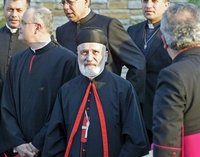 Patriarch Nasrallah Peter Sfeir, 90, the 76th head of the Maronite Church is said to have submitted a resignation a few months ago to His Holiness, Pope Benedict XVI. The Daily Star has stated this move of Sfeir’s, but the paper has several facts wrong, so the reliability of specifics is questionable.
Patriarch Nasrallah Peter Sfeir, 90, the 76th head of the Maronite Church is said to have submitted a resignation a few months ago to His Holiness, Pope Benedict XVI. The Daily Star has stated this move of Sfeir’s, but the paper has several facts wrong, so the reliability of specifics is questionable.
Saint Theodosius the Great
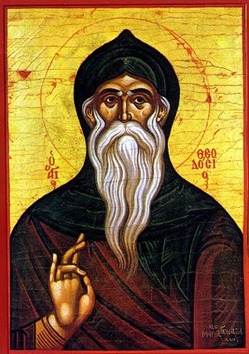 Planted in the courts of your Lord, you blossomed
Planted in the courts of your Lord, you blossomed
beautifully with virtue, and increased your children in the desert, showering them
with streams of your tears, O chief shepherd of the divine flock of God. Therefore,
we cry to you: “Rejoice, Father Theodosius.” Kondakion – Tone 8
Theodosius the Great lived during the fifth-sixth centuries, and was the
founder of cenobitic monasticism. At the monastery St Theodosius built a home
for taking in strangers, separate infirmaries for monks and laymen, and also a
shelter for the dying. Seeing that people from various lands gathered at the
Lavra, the saint arranged for services in the various languages: Greek,
Georgian and Armenian. All gathered to receive the Holy Mysteries in the large
church, where divine services were chanted in Greek.
many healings and other miracles during his life, coming to the aid of the
needy. Through his prayers he once destroyed the locusts devastating the fields
in Palestine. Also by his intercession, soldiers were saved from death, and he
also saved those perishing in shipwrecks and those lost in the desert. Once,
the saint gave orders to strike the semandron (a piece of wood hit with a
mallet), so that the brethren would gather at prayer. He told them, “The
wrath of God draws near the East.” After several days it became known that
a strong earthquake had destroyed the city of Antioch at the very hour when the
saint had summoned the brethren to prayer.
summoned to him three beloved bishops and revealed to them that he would soon
depart to the Lord. After three days, he died at the age of 105. The saint’s
body was buried with reverence in the cave in which he lived at the beginning
of his ascetic deeds.
